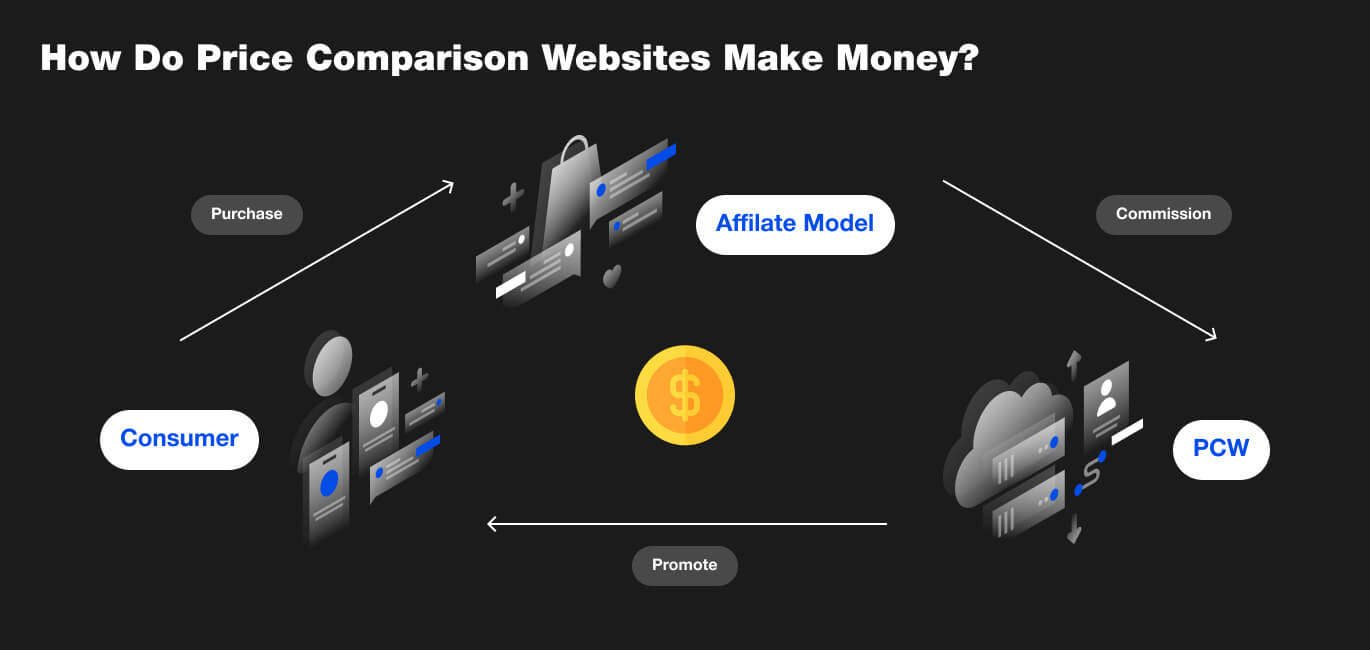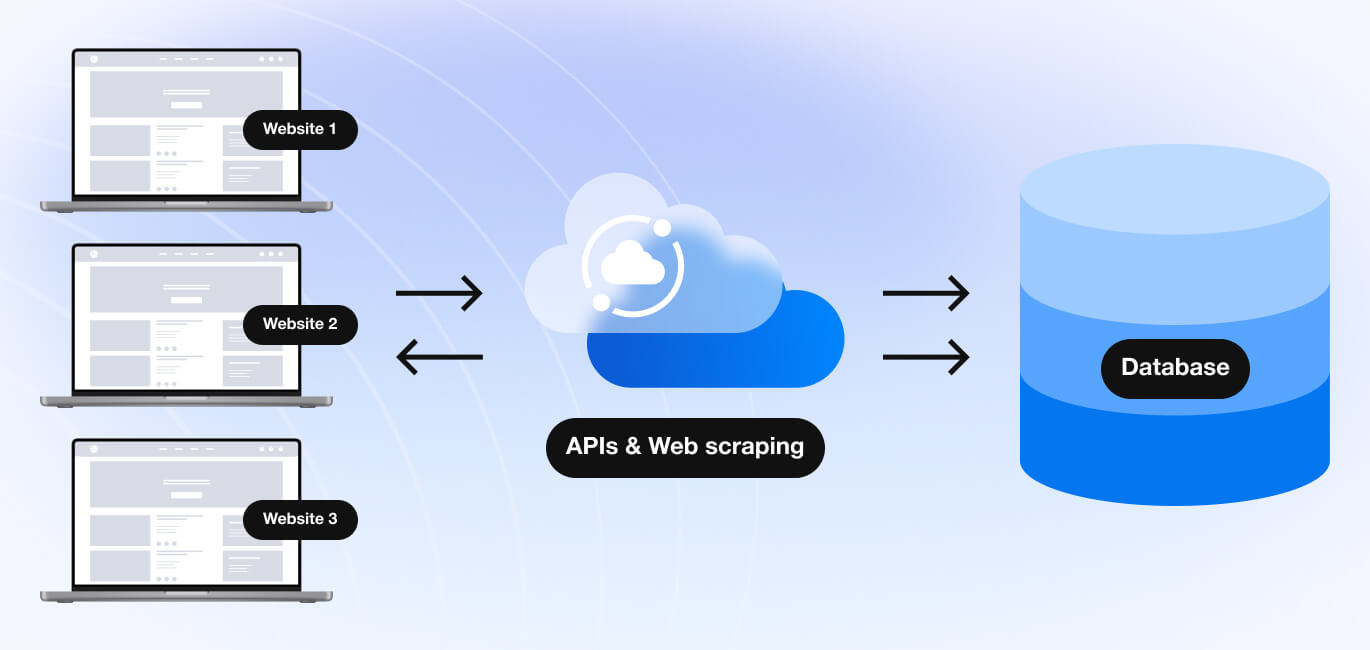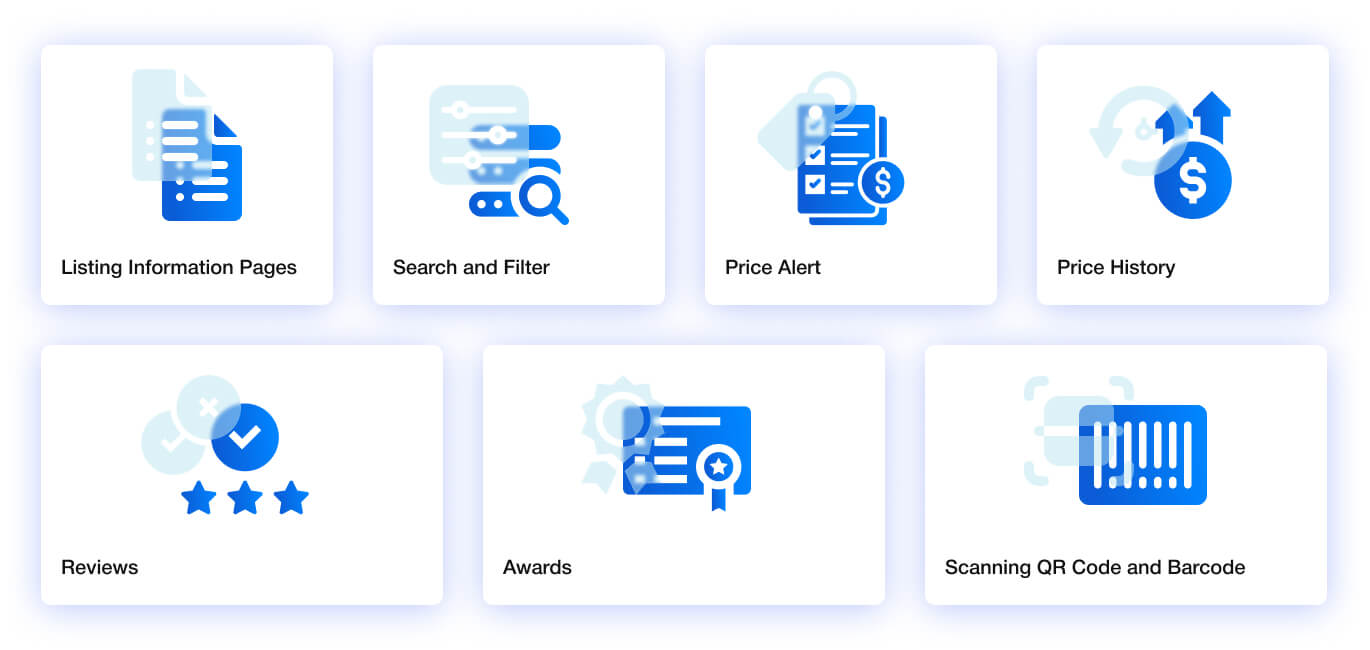How to Make a Price Comparison Website
 29 December 2021
29 December 2021As one study states, 90% of people planning to buy digital gadgets use special aggregators before making a purchase. They want to find the cheapest option before deciding in favor of a particular product. The same goes for other goods and services, both in online or offline stores. That’s why the size of the price comparison websites market is constantly growing, making it a profitable startup idea. This article will guide you on how to start a price comparison website, providing the most relevant information and useful tips.
What Is a Price Comparison Website, and Why Is It in Demand?
Let’s clarify: these websites don’t sell any products. They collect data on the product prices. Also, they usually provide the user with additional information such as a brief description, availability in stores, the product’s rating, and reviews. Thus, consumers get to compare prices and other important characteristics of the product or service. Price comparison websites (PCW) are especially handy when it comes to significant purchases like buying flights or choosing a new laptop. In these cases, it’s hard to make a choice without deep research.
Benefits of PCW
Before we dive deeper into how to make a site for price comparison, let’s pinpoint the main benefits they bring both customers and vendors.
What Buyers Get From Them
Price comparison websites are particularly popular among those who regularly shop online as a PCW:
- Saves time by giving a quick answer to the question, “Where can I get this product cheaper?”
- Lets customers make their choice based on reviews of other real customers.
- Provides a single platform for showing a huge number of online stores.
- Provides various sorting options for product offers.
- Shows customers the most popular goods as these are usually placed at the top of the lists.
Why PCW is Good for Vendors
Price comparison websites serve as an additional sales channel for sellers. Plus, they use an aggregator’s data to decide on competitive prices and receive additional traffic from the target audience. So, the suppliers’ benefits include the following:
- More purchases by customers.
- More traffic for their sites.
- PCW as an additional low-cost advertising channel.
- Opportunity to develop their resources based on customer reviews.
- Easy market entry for small and new brands.
Niches for Price Comparison Sites
When you think about a price comparison site, things like smartphones or laptops come to mind. But actually, there are various niches that you can enter with aggregating websites. Here are some main examples:
- Flights, like Google Flights, Momondo, Kayak.
- Specific services. For example, Parcel2GO can help customers find the most advantageous deal on parcel delivery in the UK. Another example is NerdWallet – a site for personal finance that compares prices on specific financial services, like getting credit cards and personal loans. It also provides a lot of useful information on taxes and so on.
- Clothing, like the Fashiola website.
- Supermarkets, like MySupermarket.
- Education, like The Good School Guide.
- The search for hotels, like Trivago.
- Gaming products, like CheapShark or Gocdkeys.
- Makeup products, like Cosmetify.
- Digital gadgets, like Smartprix.
- Travel resources, like CruiseCritic.Of course, there are giants in this market that compare products belonging to different niches like Google Shopping, Shopzilla, and others.
How to Find Your Niche
You have a lot of ideas to choose from when you start creating a niche comparison site. However, you should be ready to face tight competition. In theory, it would be ideal to choose a product or service that is high in demand with high conversion rates. In addition, it would be perfect to have very few competitors in the chosen niche.
But as of now, there are only a few niches that meet all those criteria: non-paper 3D printing and services and products based on artificial intelligence, the Internet of Things, and the blockchain.
If you are familiar with one of those, then you should definitely go for it.
If not, then it’s better to focus on a niche familiar to you and aim at a narrow audience. It’s always better to start small, get experience and loyal customers who trust you, and then move to bigger markets.
Contact us now to discuss your price comparison website project!
How Do Price Comparison Websites Make Money
Most price comparison sites use the affiliate monetization model – Cost Per Click (CPC) or Pay Per Click (PPC). Customers visit online stores through aggregators by referral links, and suppliers pay the PCW owners commission. You can sign up for affiliate programs created by popular retailers:
- Amazon Associates
- eBay Partner Network
- Walmart
- Target
- Best Buy
You can also choose affiliate networks that many companies use to manage their affiliate programs. Here are some of them:
- CJ Affiliate
- ShareASale
- FlexOffers
AvangateOther options for generating profit include:
- Commission from the order placed. You get the commission if the customer makes an order on your partner’s site. So it’s a Pay-Per Order type of monetization.
- Google Ads. It’s hard to find a PCW that doesn’t take advantage of this. The more popular your site is, the more your earnings will be.
- Paid placement. In this case, you can collect money from sellers in return for their products being placed on your site.
- Brand advertising. Certain brands pay you for the placement of their advertising offers at the top of your listings. For the brand owner to be interested in such cooperation, your PCW must be in high demand.
- Target marketing. PCW provides the perfect source of valuable information about consumer needs. Analyzing their behavior can help vendors in improving their targeted advertisements.
The best thing about PCW is that you can combine several of the monetization methods mentioned above to increase your profit.
How Price Comparison Websites Collect Data
Since fresh and valid information is at the heart of any price comparison site, let’s talk about how to obtain it.
Method #1 APIs
Application Programming Interface (API) is a software intermediary that lets two websites interact with each other. Its integration is the most common way of gathering data. You get accurate information directly from the vendors using the API, which then gets automatically entered into your database.
Pros
- Easy receiving of information in the right format and quality.
- Automated updating of product information several times a day.
- Legally approved method.
Cons
- It’s impossible to get data from vendor platforms that don’t have affiliate programs or don’t provide an API.
- Integrating with numerous API interfaces of different sites is time-consuming and demands extra expense.
Although API isn’t an easy option, many sites are starting to make listings according to industry standards which simplifies your task. In most cases, sellers will let you obtain their data for free since they will increase sales without any hassle.
Method #2 Web Scraping
This method of data extraction from site pages is called web scraping. This data extraction involves web scanners which are automated codes and/or specially trained algorithms. They regularly monitor pre-selected websites to check each internal link, parse an HTML document and look for the data.
Pros
- There is no need to ask permission from website owners to collect data (however, it’s better if you do).
- It lets you build an extensive database rather quickly.
- It is easy to integrate web scrapers with your site.
Cons
- The user won’t get a commission for redirecting customers to vendor sites.
- Additional money and time for developing web scrapers from scratch are needed.
- Many websites are designed to protect themselves from web scraping. Others might have legal protection against it.
- The information you get might not be of the desired format or quality.
This method has some really disadvantageous cons and is usually used when there’s no developed market for affiliate marketing.
Method #3 Manual Addition
If a retailer platform doesn’t have an API, vendors can send you the data on their listings in the format of XML and CSV files. CSV is a plain text format with a series of values separated by commas. XML encodes documents in a format for representing structured information. But you’ll need employees for transferring data from those files into your database. Sellers can also add the information manually if they have the appropriate interface for that.
Pros
- It’s very easy to implement.
Cons
- It takes a lot of time since it relies on manual work.
- Updating the database in real-time is impossible.
You can use this approach if your PCW deals with products or services that have static prices or if the listing includes an expert’s opinion. For example, people choose a credit card not only by price. It’s crucial for them to know if there are some hidden charges, unacceptable additional conditions, etc. That’s when experts come into play.
There’s also a rare method of manual addition, which involves buyers adding the necessary information. You can use it as an element of feedback and for identifying problems connected with other data collecting methods. It can come in handy for clarifying data as well as for increasing user’ loyalty.
Must-Have Features For a Price Comparison Website
After you’ve chosen your niche, monetization model, and the method of filling your site with information, it’s time to think about all the necessary features your platform should include. Here’s the table with the most common features of PCW below.
| Feature | Description |
|---|---|
Listing Information Pages | Usually, listings come with prices, small photos, and short descriptions. If the user wants to read the full information about the product, they are redirected to the vendor’s site. But some PCWs provide more detailed listings, which are more convenient for customers. |
Search and Filter | This feature can be implemented in several ways:
There’s also a third option: the user fills a form with requirements, your site sends the request to the suppliers. The latter submit offers to your site. |
Price Alert | It allows users to track prices changes and get notifications about them via push notifications, SMS, email, or a message in a selected messenger. |
Price History | It lets users check the price trends on their own. For example, you can add a “Compare by month” filter. |
Reviews | Users trust other people’s reviews, and having this feature will increase their loyalty. |
Awards | This is an optional feature, but it will definitely attract more visitors to your site. For example, you can give bonuses or badges if a user leaves a review. |
Scanning QR Code and Barcode (optional) | Using a smartphone’s camera, a user can compare prices in local stores. |
After you’ve selected the features for your future website, it’s time to make its prototype and design. There are two stages of prototyping:
- Creating a low-fidelity prototype – a general website model visualizing all features and layout elements. With it, you can check and test the platform’s functionality.
- Creating a high-fidelity prototype that has detailed UI design, real content, and real interactivity. At this point, the testing starts that will let you fix overlooked bugs.
Then you can move to MVP development. A Minimum Viable Product (MVP) is the earliest version of the platform that you can launch on the market.
How Much Does It Cost to Make a Price Comparison Website
The cost to develop a price comparison site can be estimated depending on which path you want to take in its development. There are two main options which both have advantages and disadvantages.
Using a Price Comparison Website Template
A well-known price comparison site will be the base for yours. Basically, it will be a clone with some tweaks.
Pros
- The simplicity of the solution means a fast development process.
- It costs much less than starting from scratch.
Cons
- Limited functionality.
- You won’t be able to add additional features.
Using a Built-From-Scratch Solution
If you’ve come up with a unique idea for how to create your own niche price comparison site, then a custom-developed product is a must.
Pros
- You have all the freedom when it comes to the creative side of the work.
- Extending a platform’s functionality isn’t a problem.
Cons
- This is an expensive and time-consuming solution.
When we say “expensive”, how much is it in reality? To get an idea, you have to start by identifying the main features of your future website. This information will help you to decide on different tech stacks and UI/UX design requirements.
If you go for the standard functionality pack we’ve mentioned before, then your core development team will include:
- Product/Project manager. Their main role is to be responsible for planning and overseeing the development process.
- UX/UI designers. They help to create user-centered designs mapping out the customer experience.
- Front-end developer. They develop and maintain the user interface.
- QA tester. Their job involves testing, reviewing, and assessing the website.
- Backend developers. They work on creating a server-side web application logic and integrations.
In addition, you might need to hire additional specialists:
- Business analyst. This person helps you conduct market analyses which are important at the niche selection stage.
- Chief technology officer (CTO). Their main role is to oversee the entire technological process and supervise the entire coding process.
Here’s the table with approximate hourly rates of the core development team below.
North America | Central Europe | Eastern Europe | South America | Asia | |
|---|---|---|---|---|---|
Middle Software Engineer | $65 – $90 | $35 – $70 | $25 – $40 | $25 – $60 | $25 – $35 |
Middle UX/UI Designer | $55 – $85 | $35 – $65 | $25 – $35 | $30 – $45 | $20 – $35 |
Middle QA | $70 – $90 | $30 – $80 | $25 – $40 | $40 – $50 | $20 – $35 |
DevOps | $70 – $90 | $55 – $70 | $40 – $60 | $40 – $65 | $20 – $40 |
Project Manager | $85 – $95 | $50 – $70 | $25 – $65 | $40 – $70 | $30 – $50 |
Source: geniusee.com
Usually, you will need one of each expert to create a price comparison website unless you have a tight deadline, which leads to a cut-off team with jack-of-all-trades specialists.
A CCST estimate of a price comparison website development should also include the understanding of a timeframe. Let’s say your MVP will only have core features. Then you will need at least three months to finish the development. This all leads to the conclusion that the total sum starts with $32,000.
Final Words
Now that you’re armored with all the key information on the question “How to build a comparison website?” It’s time for action. It’s up to you to decide whether you want to hire freelance experts or find an outsourcing company. If you’re going the latter route, take your time to choose the right one.
Attract Group team has extensive experience in creating price comparison websites of different complexities and functionality. You can rely on the expertise of our web developers who will be glad to answer all your questions. Don’t hesitate to contact us to discuss your business ideas!













